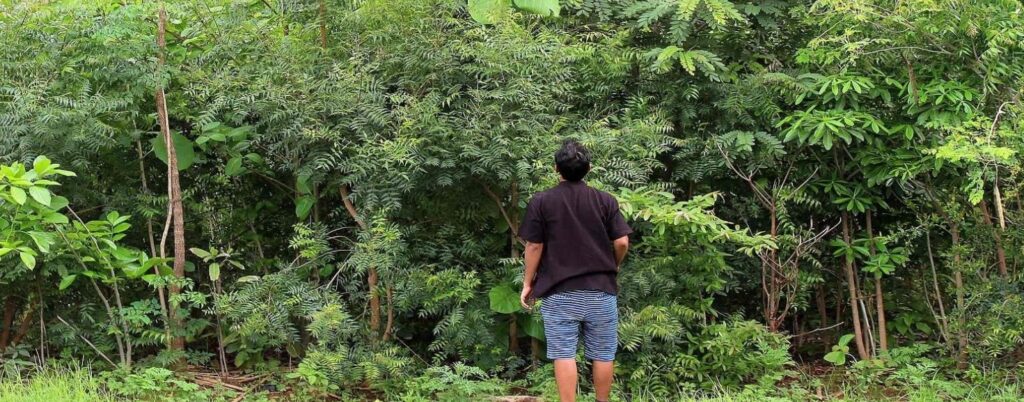The State We're In
Can ‘tiny forests’ help New Jersey’s cities?
What’s the size of about 10 car parking spots, improves air quality, attracts butterflies and other wildlife, and enhances biodiversity?
It’s a “tiny forest!” While many folks think of forests as places big enough to get lost in, tiny forests can be small spots that are densely planted with native trees, shrubs and plants. You might not get lost in one, but you’d very likely come away feeling inspired!
Around the world, there’s a growing movement to create tiny forests in cities to improve their livability and help fight climate change. Micro forests do most of the things large forests do: absorb carbon from the air, soak up storm water, provide habitat for wildlife, and cool the air in summer. They also help muffle city noise.
As the nation’s most urbanized state, New Jersey has many places just perfect for tiny forests. Most of the Garden State’s older cities have abandoned lots and there are already successful examples of converting abandoned lots into urban gardens.
The tiny forest movement began in Japan over 40 years ago, when botany professor Dr. Akira Miyawaki was researching methods of reforesting degraded land. He learned that with the proper soil preparation and optimal mix of native plants, accelerated growth is possible.
A barren patch of land planted using the “Miyawaki method” can grow about a meter (slightly over three feet) a year and start looking like a forest in as little as three years, as opposed to decades for seedlings planted in an existing large forest. This “pop-up” effect makes tiny forest plantings a rewarding experience for urban schoolchildren and neighborhood volunteer groups.
During the 2011 tsunami in Japan, a tiny forest planted by Miyawaki eight years earlier stood firm and helped protect a local business from flood debris, while other local plantings washed away. Based on Miyawaki’s work, a “great green forest wall” of 14 million native trees is now being built along Japan’s east coast. Miyawaki, 93, won a Blue Planet Award and many other accolades for his work.
Miyawaki’s method has gained recognition around the globe thanks to the efforts of Shubhendu Sharma, an Indian industrial engineer turned forester. Sharma became a tiny forest convert after hearing Miyawaki speak. He planted his own micro forest in the back yard of his family home in northern India, but initially wasn’t successful because he included non-native plants. Once he switched to all native species, his tiny forest thrived.
“It can take hundreds of years for a forest to rejuvenate on its own,” Sharma told an interviewer. “But we don’t have that kind of time. Here, we’re looking at a methodology that converts a barren patch of land into a thriving forest in a span of three years. It was like a huge ray of hope.”
Using his experience designing assembly lines for Toyota, Sharma created a standard operating procedure for replicating Miyawaki’s results anywhere in the world. His venture, known as Afforestt, turned Miyawaki’s method into an open source, step-by-step manual for building tiny forests.
The theory behind the Miyawaki method is that by planting vegetation far more densely than in a conventional forest, trees will grow tall quickly to compete with each other for sunlight and water. And that by using the right mix of trees and shrubs that grow to varying heights, the forest will end up with lush, verdant layers.
Want to plant your own tiny forest? Here are the basic steps:
- Work with a nursery or plant expert to learn what trees, shrubs and herbaceous plants grow naturally in your region. Native plants do much better than non-natives, with less maintenance, and will attract more diverse native wildlife;
- Soil in developed urban areas is likely compacted, so prepare the ground by turning the soil and adding organic soil amenities like wood chips, charcoal, and healthy soil inoculants such as fungi and micro-organisms.
- Plant the seedlings close together, about five saplings per square meter (slightly larger than a square yard), using sticks for support;
- Add a mulch layer on top of the soil to keep moisture from evaporating;
- Keep the forest well-watered during periods without rainfall, and free from weeds for the first two years.
In two to three years a tiny forest should be well enough established to take care of itself with minimal upkeep. Then it’s time to reap the ecological benefits of the mini oasis!
So far, more tiny forests have been created in Asia and Europe than in the United States. But with Afforestt’s guidance, Miyawaki micro forests have been planted in Seneca, South Carolina, and Maysville, Missouri.
It seems only a matter of time until the idea spreads in the U.S. And while most tiny forests have been built in cities, they are a great idea for suburban areas with too much grassy lawn and too few trees. Suburban tiny forests would have to be fenced to keep out browsing deer, which are found in all but New Jersey’s most urbanized neighborhoods and strongly prefer native species.
For more information on tiny forests, check out a great new BBC podcast, “A forest down your street,” at https://www.bbc.co.uk/sounds/play/p094c7jm. More information is available on Shubhendu Sharma’s Afforestt website at https://www.afforestt.com/. Sharma also gave a well-received TED Talk that can be seen at https://www.ted.com/talks/shubhendu_sharma_an_engineer_s_vision_for_tiny_forests_everywhere?language=en.
And to learn about preserving New Jersey’s land and natural resources, visit the New Jersey Conservation Foundation website at www.njconservation.org or contact me at info@njconservation.org.
About the Authors
Alison Mitchell
Co-Executive Director
John S. Watson, Jr.
Co-Executive Director
Tom Gilbert
Co-Executive Director, 2022-2023
Michele S. Byers
Executive Director, 1999-2021
View their full bios here.
Filter
Get The Latest News
From The Garden State
In the
News

